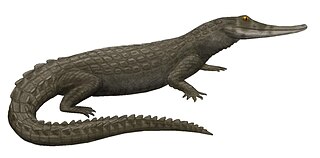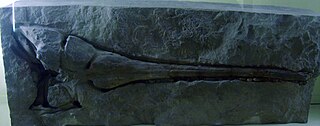
Mesoeucrocodylia is the clade that includes Eusuchia and crocodyliforms formerly placed in the paraphyletic group Mesosuchia. The group appeared during the Early Jurassic, and continues to the present day.

Simosuchus is an extinct genus of notosuchian crocodylomorphs from the Late Cretaceous of Madagascar. It is named for its unusually short skull. Fully grown individuals were about 0.75 metres (2.5 ft) in length. The type species is Simosuchus clarki, found from the Maevarano Formation in Mahajanga Province, although one isolated multicuspid tooth of this genus was discovered in Kallamedu Formation of India.

Mariliasuchus is an extinct genus of Late Cretaceous notosuchian mesoeucrocodylian found near Marilia, Brazil. The first bone remains were found and collected in 1995 by Brazilian paleontologist William Nava, in red rocks from the fossiliferous Adamantina Formation. Four years later, it was described as Mariliasuchus amarali, by Brazilian paleontologists Ismar de Souza Carvalho and Reinaldo J. Bertini.
Hyposaurus is a genus of extinct marine dyrosaurid crocodyliform. Fossils have been found in Paleocene aged rocks of the Iullemmeden Basin in West Africa, Campanian–Maastrichtian Shendi Formation of Sudan and Maastrichtian through Danian strata in New Jersey, Alabama and South Carolina. Isolated teeth comparable to Hyposaurus have also been found in Thanetian strata of Virginia. It was related to Dyrosaurus. The priority of the species H. rogersii has been debated, however there is no sound basis for the recognition of more than one species from North America. The other North American species are therefore considered nomina vanum.
Pachycheilosuchus is an extinct genus of neosuchian from the Early Cretaceous of Texas, United States. Previously known, in part, as the "Glen Rose form", this crocodylomorph is notable for its procoelous vertebrae, otherwise found only in derived eusuchian crocodilians, a thick margin on the maxillae, and a shield of armor on the neck formed by the fusion of six individual scutes.
Neuquensuchus is an extinct genus of crocodyliform from the Santonian-age Upper Cretaceous Bajo de la Carpa Formation of Neuquén Province, Argentina. The known remains were discovered on the campus of Universidad Nacional del Comahue in the city of Neuquén. Neuquensuchus was named by Lucas E. Fiorelli and Jorge O. Calvo in a publication dated to 2007, but which became available in 2008. The type species is N. universitas, in recognition of its discovery locality. Unlike the great majority of crocodyliforms, its shin was longer than its thigh, suggesting it had some running ability.
Rugosuchus is an extinct genus of neosuchian crocodyliform from the late Early Cretaceous of China. It is known from most of a skull, a partial postcranial skeleton, and a second partial skeleton including part of the hips. It was described by Xiao-Chun Wu and colleagues in 2001, with R. nonganensis as the type species. At the time of its description, it was the most complete crocodyliform from northeastern China, and only the second known.

Eusuchia is a clade of neosuchian crocodylomorphs that first appeared in the Early Cretaceous, which includes modern crocodilians. Along with Dyrosauridae and Sebecosuchia, they were the only crocodyliformes who survived the K-Pg extinction.
Trematochampsidae is an extinct family of mesoeucrocodylian crocodylomorphs. Fossils are present from Madagascar, Morocco, Niger, Argentina, and Brazil. Possible trematochampsids have been found from Spain and France, but classification past the family level is indeterminant. The trematochampsids first appeared during the Barremian stage of the Early Cretaceous and became extinct during the late Maastrichtian stage of the Late Cretaceous.

Eutretauranosuchus is an extinct genus of goniopholidid crocodyliform. E. delfsi is the only known species within the genus.

Armadillosuchus is an extinct genus of sphagesaurid crocodylomorph. It was described in February 2009 from the late Campanian to early Maastrichtian Adamantina Formation of the Bauru Basin in Brazil, dating to approximately 70 Ma. Armadillosuchus was among the larger and more robust sphagesaurids, with a total length of approximately 2 metres (6.6 ft).
Gilchristosuchus is an extinct genus of neosuchian crocodyliform. Its fossils have been found in the upper Milk River Formation of Alberta, Canada, in rocks of either latest Santonian or earliest Campanian age. Gilchristosuchus was described in 1993 by Wu and Brinkman. The type species is G. palatinus, in reference to its distinctive palatine bones.

Isisfordia is an extinct genus of crocodyliform closely related to crocodilians that lived in Australia during the Middle Cretaceous (Albian–Cenomanian).

Pholidosaurus is an extinct genus of neosuchian crocodylomorph. It is the type genus of the family Pholidosauridae. Fossils have been found in northwestern Germany. The genus is known to have existed during the Berriasian-Albian stages of the Early Cretaceous. Fossil material found from the Annero and Jydegård Formations in Skåne, Sweden and on the island of Bornholm, Denmark, have been referred to as a mesoeucrocodylian, and possibly represent the genus Pholidosaurus.
Paluxysuchus is an extinct genus of neosuchian crocodyliform known from the Early Cretaceous Twin Mountains Formation of north-central Texas. It contains a single species, Paluxysuchus newmani. Paluxysuchus is one of three crocodyliforms known from the Early Cretaceous of Texas, the others being Pachycheilosuchus and an unnamed species referred to as the "Glen Rose Form". Paluxysuchus has a long, flat skull that is probably transitional between the long and narrow skulls of many early neosuchians and the short and flat skulls of later neosuchians.
Hulkepholis is an extinct genus of goniopholidid mesoeucrocodylian from the Early Cretaceous of southern England and eastern Spain. It contains two species, the type species, Hulkepholis willetti, and also H. plotos. Hulkepholis is most closely related to both species of Anteophthalmosuchus.

Coelognathosuchia is an extinct clade of neosuchian crocodyliforms that includes all taxa more closely related to the family Pholidosauridae than to Bernissartia fagesii or Eusuchia. Martin et al. (2014) named the clade after finding goniopholidids and pholidosaurids to group together in their phylogenetic analysis of crocodyliform evolutionary relationships. In their analysis, Pholidosauridae was monophyletic and Goniopholididae was paraphyletic, being an assemblage of successively more basal taxa within Coelognathosuchia. Coelognathosuchia itself was positioned near the base of the larger clade Neosuchia as the sister group to a clade containing the Early Cretaceous neosuchian Bernissartia and Eusuchia, the group that includes all modern crocodilians and their closest extinct relatives.

Confractosuchus is a genus of extinct eusuchian crocodyliform from the Cretaceous Winton Formation of Australia. Described as a macro-generalist, Confractosuchus was found with the bones of a juvenile ornithopod dinosaur in its abdomen. It currently contains a single species, Confractosuchus sauroktonos, which literally means "broken dinosaur killer."
Titanochampsa is a genus of large mesoeucrocodylian from the Maastrichtian Marilia Formation of Brazil. Although only known from a single skull roof, the material shows that Titanochampsa was not a member of Notosuchia, which were previously believed to have been the only crocodyliforms present in the strata of the Bauru Group. Body size estimates vary greatly and range between 2.98–5.88 m due to the incomplete nature of the holotype fossil. The overall anatomy of the skull roof, alongside its size and possible affinities with Neosuchians, may suggest that it was a semi-aquatic ambush hunter similar to modern crocodilians.
Varanosuchus is an extinct genus of atoposaurid neosuchian from the Early Cretaceous Sao Khua Formation of Thailand. Varanosuchus is known from three individuals which preserve assorted postcranial material and a complete skull. The skull of Varanosuchus was altirostral, meaning it wasn't flattened like in modern crocodilians and instead much deeper, while the limbs were slender and straight, leading to it somewhat resembling a monitor lizard. Little is known about the ecology of atoposaurids, however, based on the slender, erect limbs, the altirostral skull and the well ornamented osteoderms it has been suggested that Varanosuchus was a terrestrial animal with some semi-aquatic affinities. Only a single species is recognized, Varanosuchus sakonnakhonensis.
















